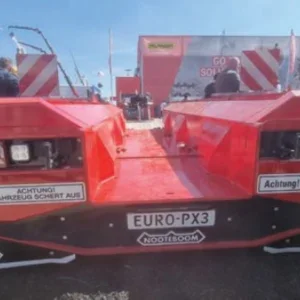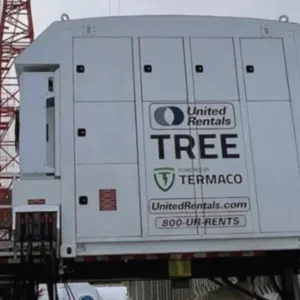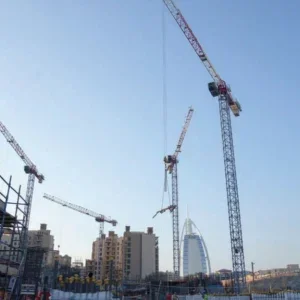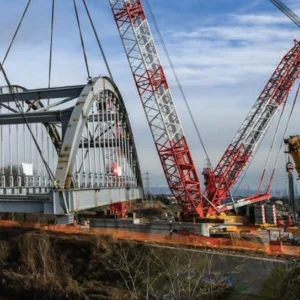To many in the crane hire business, particularly those in Europe, the rough terrain (RT) market is often seen as a poor cousin to the high-technology all terrain (AT) sector. Lifting capacities are lower, the carrier is often less sophisticated and rough terrains are generally lower cost machines.
But for plenty of US firms, along with those in the Far East, the rough terrain crane is an essential component of the fleet. Indeed crane giants such as All Erection & Crane Rental in the States have more than 1,200 rough terrain cranes on their fleets, more than many crane rental firms can muster in all sectors.
The rough terrain is in many ways more like a telescopic handler than a specialist AT crane. It can lift and carry, unlike the sophisticated all terrain, and often stays on site throughout the duration of the job. This is partly due to the fact that in most countries, apart from Japan, it is not possible, or indeed practical, to drive a rough terrain crane any distance on the highway. Once it has been transported to the site, therefore, you need to make the most of the machine before it is taken away again.
It is probably this transportation problem, more than any other factor, that drives European rental companies towards the all-terrain rather than the rough terrain crane. Though the lower entry cost and increased practicality on site tend to push contractors and end users towards the well proven RT.
As mentioned, both the USA and the Far East have been big markets for RT cranes, though both have suffered over recent years. But the signs are that these markets are picking up, with a corresponding rise in sales of rough terrain cranes.
‘We’re pleased to say that after a couple of flat years we’re seeing a strong return to buying in the USA,’ says Manitowoc Crane Group’s senior vice president for sales and marketing Dave Birkhauser.
‘Our customers that work in oilfields and industrial production are particularly busy, while those in general construction are talking about a pick up in work levels after a slow period.
‘Rough terrain sales form the backbone of our mobile crane sales in North America. They’re the workhorses of the jobsite and remain incredibly popular with contractors and rental companies alike,’ says Birkhauser.
It’s a view that is shared by fellow US company Terex Waverly. ‘We see a fairly strong market in the 35, 55, 65, 75 and 100 tonne plus sectors,’ says Terex Waverly’s rough terrain and truck crane sales director Tom Limbach.
‘I don’t know that the market will be going back to the glory days, but it is 15-20 per cent stronger this year.’
Things are looking good for the coming year too. ‘Yes, we see further growth next year too,’ says Limbach.
In fact the only thing holding the market back is not demand from end users, but the supply of raw materials for crane manufacture. ‘We are holding our own. Our business is up and our shares are up. But we are limited by global material issues,’ says Limbach.
Though most European countries shy away from the rough terrain crane there is one notable exception. Italy remains a strong customer for the RT manufacturers, a number of which are not surprisingly based in the country.
Marco Gentilini, of Terex Italia, believes that Italy represented around 70 per cent of the RT market in Europe last year, with sales totalling around 250 machines, or 10 per cent of the global RT market. There has been strong market performance over the last two years in Italy, up from its more normal 100-150 units a year total.
Gentilini says there are a number of reasons for this sector’s growth. The main one was support from the Italian government in 2002 for investments in industrial construction, along with the start of several important infrastructure projects, like the high speed rail links from Milan to Bologna and Turin to Milan.
Now that these projects are up and running, he is expecting Italian RT sales to fall back slightly, though he predicts that the market will remain healthy.
Birkhauser is keen to see further sales growth of the Grove RT in Europe. ‘Europe has traditionally been an all terrain market and our customers there continue to favour AT machines over rough terrains,’ he says.
‘However we continue to improve market share and this year has been particularly successful. Recent months have seen us deliver rough terrain cranes into Belgium and Italy in Europe, along with Oman in the Middle East and Equatorial Guinea in Africa.’
However things have been particularly good for Terex Italia in sales and market share terms. ‘In our case we recorded a top year in 2003,’ says Gentilini. ‘With the sale of 241 units against the very good 2002 (227 units) and the historical trend of 130-150 a year. We as Terex Italia increased our market share in Europe to over 60 per cent in 2003, and we estimate a worldwide market share growth from below 5 per cent before 2000, to over 10 per cent in 2002 and 2003.
‘We expect 2004 to be weaker in Italy than the last two years and Europe will be little better. But the demand from the near East and the African market appears very interesting. We are playing a leading role in Italy and Europe, but our presence in the world market is still small, but at least we are at two digits and growing. We look at Africa and the near East markets as areas where our products should reach more success and increased sales and market share.’
This gaze East is shared by the US manufacturers. ‘We export 25 per cent of our production to the Far East as well as South America, says Terex Waverly’s Limbach. That said, he believes there is little demand for cranes from China yet, and the Chinese are building their own machinery.
Japanese manufacturer Tadano’s Futoshi Kimura says that the firm is seeing a strengthening of RT sales in both the USA and in the Asian markets, though he comments that Europe is ‘still swimming at the bottom’. In fact Tadano is increasing its sales force in Asia to meet growing demand in Japan and other countries, though he too says that as yet China, which offers such tremendous potential, is not providing much of an outlet for the company.
And it’s not just the workforce that is growing at Tadano, as the firm will introduce a number of new and improved models for all markets. The company will launch two models at the Conexpo exhibition in the USA next year. These include the 60 ton capacity TR-600XXL and the 30 ton lift TR-300XL for the American market.
Tadano is also set to unveil the 30 ton capacity GR-300EX for the European market and the GR-700EXL, which has a 70 ton lift capacity and is designed for the Asian markets.
‘We are launching new models to increase market share in North America, Europe and the Far East,’ says Kimura.
Tadano is not alone in introducing additional machinery to the RT market. Terex Italia unveiled the RC45 at Bauma this year. This two-axle RT offers a maximum lifting capacity of 44 tonnes at a 2.5m radius. It comes with a 37.4m boom and the four wheel drive and the all-wheel steer chassis is powered by a 113kW Cummins motor.
Terex Waverly is promising new RT product for next year’s Conexpo show too, though at present the firm is keeping its cards very close to its chest.
Grove too has been busy since it was taken over by the Manitowoc Crane Group, with the introduction this August of the 75 ton rated RT875E, which will make its first public appearance at Conexpo next year. This RT uses a four-stage Megaform boom, giving a maximum tip height of 41.4m. A lattice extension and inserts are available which boost this tip height to a maximum of 69.6m. To meet the needs of operators working with the full stick the RT875E has a tilting crane cab which can be laid back by as much as 20 degrees. The crane also has a hydraulic counterweight removal system.
This is the second new RT from Grove in the last year, with the launch last November of the 90 ton RT890E. This crane uses a five-section Megaform boom with a tip height of 42.6m. Standard and hydraulic luffing swingaway jibs are available which, with additional inserts, offer tip heights up to 70.8m.
‘We have worked very hard on rationalising our product line,’ says Birkhauser. ‘We have seven models in our E series range from 25-130 ton capacity, all of which have been introduced over the last five years. We have listened hard to what our customers want from a rough terrain crane and have tailored our range to meet these requirements.
‘The second reason for our increasing sales success can be put down to our integration into the Manitowoc Crane Group in 2002. As a result we now boast the biggest and best crane distribution network in the world,’ he claims.
Unlike the all terrain crane, which is predominantly owned by rental companies and specialist lifting firms, the RT is just as popular with end users and contractors. ‘There is a definite market for them in a number of countries and on many projects they are simply the best tool for the job,’ says Grove’s Birkhauser.
‘However there has been a cultural preference for all terrain cranes in Europe for more than 20 years now and that is unlikely to change.’






